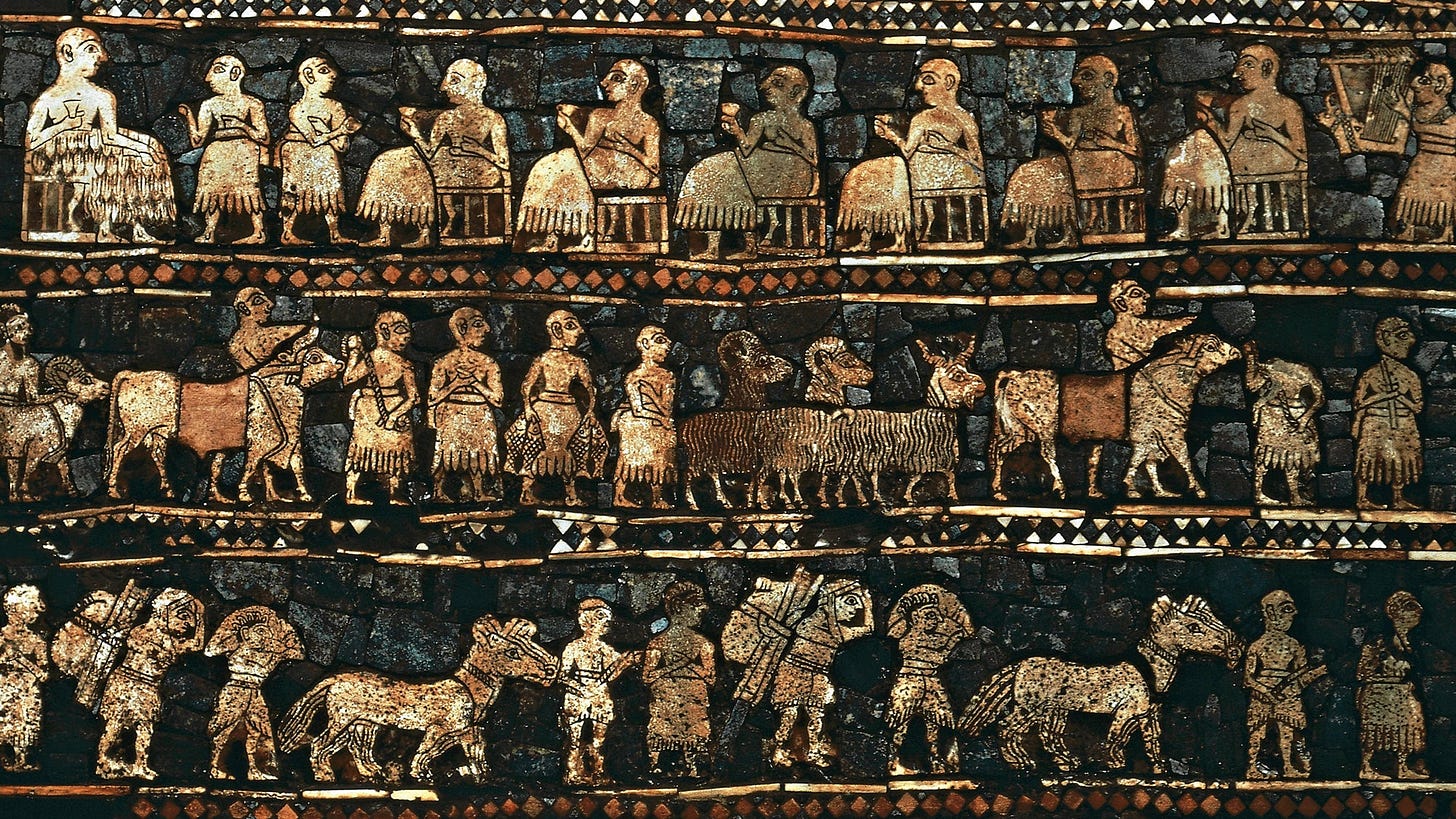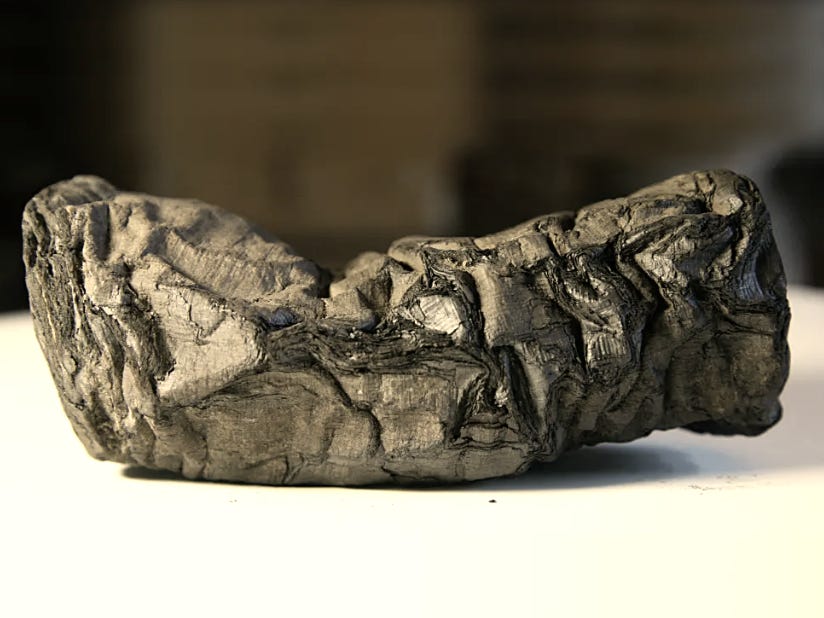Civilization is Way Older than We Think
In the past technological developments compounded very slowly, yet somehow the Sumerians invented dozens of incredibly important things. Or they just take credit for it.
The common narrative is that civilization is roughly 5,000 years old, starting with the rise of the Sumerians in Mesopotamia. This timeline hinges on material artifacts and written records, which aren’t very good at surviving very long. We also have the mental model that technological progress compounded very slowly in the past. This leads to a very simple logical contradiction:
Ancient civilizations experienced very slow rates of technological progress because communication, trade, and the compounding principle (existing tech) were all limited
A single civilization invented more than a dozen critical branches of technology all at once in a short time-span.
I think we need to pick one and stick with it. It’s just nonsensical to believe that somehow all civilizations and technology advanced very slowly except for this one group that got everything right all at once.
So, what did the Sumerians accomplish?
The Sumerian Miracle
The Sumerians were around between 3000 - 3500 BCE and are usually taken as ‘the start’ of civilization. Here’s their list of accomplishments:
Writing: Cuneiform script, ~3100 BCE.
The Wheel: Initially for pottery, later adapted for transportation, ~3500 BCE.
Irrigation Systems: Complex canals, levees, and reservoirs, ~3000 BCE.
The Plow: Oxen-drawn plows revolutionized agriculture, ~3000 BCE.
Mathematics: A base-60 number system that influences modern timekeeping, ~3000 BCE.
Astronomy: Systematic observations of celestial bodies, ~3000 BCE.
Legal Systems: The Code of Ur-Nammu, predating Hammurabi’s code, ~2400 BCE.
Sailboats: Used for trade and transportation along rivers, ~3500 BCE.
Standardized Measurements: Essential for trade and construction, ~3000 BCE.
Cylinder Seals: Early forms of identification, ~3100 BCE.
Beer Brewing: Integral to both social and religious practices, ~3100 BCE.
Medicine: Including herbal remedies and basic surgical procedures, ~2500 BCE.
We attribute these all to Sumerians because they are the earliest civilization that has material artifacts showing evidence of these. It’s hard to convey just how shallow and naive of a conclusion this is, but its firmly rooted in the kind of maximal skepticism that is taken as the de facto safe bet in science. Speculating that there might’ve been a gradual accumulation of technology over the previous thousands of years for some reason is too much of a leap for the archeologists I suppose.
It seems far more likely to me that the Sumerians didn’t invent everything on their own but simply adopted technology that had been gradually accumulating over a much longer time-span. Of the two propositions, tech grows slowly, or, one civilization invented everything all at once, the much more likely proposition seems to be that tech grows slowly, because that is what appears to be the case across very large periods of recorded time.
Event Horizons in Archeology
A much simpler way to reconcile the astounding accomplishments of the Sumerians with the evidently slow growth of technology in the past is this: material artifacts have a hard time surviving long periods of time, and so there is an apparent ‘event horizon’ in archeology that it is difficult to peer past. Things just decay and break down over time, there’s no way around it. If you’re looking for evidence of sailboats, written records, clay pots, etc, each of this doesn’t simply ‘last forever’ - they have a shelf life.
Whatever that shelf life is would set the maximum possible date in the past for you to believe people had those things if you are strictly skeptical and say that without direct material evidence its not safe to infer anything about what they had.
There’s a slightly different way to think about these things however, and its to look at ‘what is implied by this other object.’ For example, if you visited a distant alien planet and found a basket of ball-point pens that were all identical to each other, what could you infer? The safest bet would be “they had ball point pens” but this is pretty lazy and dumb. A reasonable next-guess would be “they had writing” and so you might also infer they had things to write on, like paper, but that the paper didn’t survive material degradation. You can go a step further however, and say they probably had things important enough to write down, which might imply cultural inventions like laws, trade systems, stories and narratives, family ancestry records, and so on.
If you think a bit more carefully you might also reach further conclusions based on the ball point pens themselves. For example, if the pens were all identical to high degree of precision you might reliably infer that the civilization also had mass production or manufacturing methods. This implies not just a high degree of labor specialization but all the things implied by manufacturing itself - production lines, metal tooling, factories, supply chains, and so on. But an economy does not run on ball point pens alone, for there to be factories specializing in ball-point pens its likely they satisfied a lot of other lower-level needs first. Clothing, transportation, construction materials, food, etc, were likely all produced in specialized processes that achieved economies of scale long before the society turned its head towards ball-point pens. It’s just not a safe bet to think that people in the past were actually quite dumb and didn’t have sensible priorities - you have to assume they were reasonably intelligent and focused on survival and abundance like at any time of history.
Unfortunately ball point pens don’t last forever so their historical event horizon is likely quite short. You know what lasts a long time? Stone monuments.
Gobleki Tepe Likely Wasn’t a White Elephant
The parable of a White Elephant is a gift that is ruinous to person who possesses it. It is large, ornate, expensive to upkeep, and basically destroys the holder. Gobleki Tepe is an archeological dig site in Turkey that is estimated to be 11,000 - 12,000 years old, far older than Stonehenge or the Pyramids, or the Sumerians. It has monumental stone architecture and blocks weighing 10-20 tons that are upright in a well-laid out pattern and is thought to have been used for religious ceremonies. The site where this particular dig is on is actually much larger and there is some mystery into its management, mainly that a large amount of land has been planted with trees whose roots will eventually damage and destroy the underlying remains that have yet to be excavated. You would think that such a find which could radically upend our history of civilization would be a very important thing to study in-depth, but instead the company which owns the land has pivoted to building concrete roadways, steel structures, and planting trees, ostensibly to make it into a tourist attraction and make a quick dime. Blame Big Tourism for getting in the way of sincere science, and of course for some reason the WEF and Klaus Schwab are involved in making this a tourism site instead of something that advances true knowledge.
Back to the point at hand - what can we reasonably infer about the past? Extending the ball-point pen analogy to Gobleki Tepe is simple. Would a civilization that is barely surviving go through great lengths to construct massive stone monuments that are cut and located with fairly good accuracy and precision, while they starve and die early deaths clad in tattered loincloths? Probably not. Actually, almost definitely not. Consider it guaranteed that a society capable of constructing such a large site also had pretty basic things like an understanding of structural engineering, which implies some amount of mathematics, and stone-cutting and masonry, which implies specialization of labor roles, and likely some kind of record-keeping system to keep track of who does what and where, which implies writing.
Assuming that the civilization that built this had basically no other technology and did it as a massive Hail Mary is to think they gifted themselves a White Elephant and basically bankrupted their own society for no good reason. A far safer bet is to think they built this religious site for ceremonies after achieving a relatively secure level of technological development that satisfied their other basic needs - like having built shelters, feeding themselves adequately, making pots to store food, and vehicles or methods capable of transporting 10-20 ton stone blocks up a hill. Yes, that’s right, Gobleki Tepe was built on a hill that otherwise doesn’t have many giant rectangular stone blocks just lying around.
Cyclical Civilizations
Theres a further point we can make here which is that the civilization that constructed Gobleki Tepe was probably a lot more competent than we take for granted but all that remains is their giant stone monumental architecture. Even stone monuments don’t last forever, however, since over time they are usually buried by successive layers of sedimentation from naturally occurring geological processes and the decay of things like forests and swamps. Given the evidence of the past is constantly being erased we are actually in no position to firmly conclude that even Gobleki Tepe represents the earliest advanced civilization.
Perhaps the greatest tragedy in the history of human history was the destruction of the Library of Alexandria, which has actually been destroyed several times over its history but at its peak contained over 1 million scrolls on everything from history, mathematics, science, religion - all the good stuff. The first destruction is attributed to Julius Ceasar in 48 BCE who, during the Roman Civil War laid siege to the city of Alexandria. To prevent his ships from being captured he ordered them burned, and this fire spread to the city and destroyed some parts of the library as well. A few hundred years later the Christian Roman Emperor Theodosius I issues a degree banning pagan practices, which in 415 or 416 CE incensed a mob of Christian Zelots led by Peter the Lector to capture the chief librarian Hypatia, drag her through the streets, beat her to death with roofing tiles, scrape flesh from her bones with abalone shells, and then burn the library. Hypatia was a pagan who spoke publicly about a non-Christian philosophy, Neoplatonism, which set her out as a clear target during that time of unrest. The library took another big hit in 642 CE when the Muslims conquered Egypt, and according to a 13th-century chronicler the Caliph Omar ordered the destruction of the library’s remaining books, stating “if these writings of the Greeks agree with the Book of God, they are useless and not need be preserved; if they disagree, they are pernicious and out to be destroyed.”
A lot of our knowledge of the ancient world isn’t from direct texts but rather statements about what those texts contained; for example Sophocles is said to have written 120 plays yet only seven complete plays exist today. One of the more curious scrolls said to have been stored at the Libary of Alexandria is the “Books of Berossus” - a chronicler of Babylonian kings and contemporary of Alexander the Great. His historical records claimed to span a period of over 150,000 years starting with the Age of Gods (including Marduk, one of the Sumerian gods), and made interesting claims like a fish-headed monster which didn’t need to eat emerged from the sea and taught men things like writing and mathematics.
Monster-lore aside, the astounding fact is that historians during antiquity were earnestly pursuing records of events that stretched so far back into ‘pre-civilizational’ history of hundreds of thousands of years or more, that it boggles the mind and defies our current models of civilizational history. Considering the constant cycles of turmoil, strife, Pagan-burning, and conquest that frequently destroy written records, it’s no surprise that our knowledge of the remote past is extremely spotty and suspect.
There’s hope, however. Nat Friedman has launched a project called the Vesuvius Challenge that is using CT-scanning and ML methods to decode ancient scrolls preserved in ash by the destruction of Pompeii by the eruption of Mount Vesuvius in 79 AD. The buried villa was first found in 1750 by a farmer, which contained an extensive library collection. Previously it was thought impossible to gain information from scolls that are this old and damaged, since attempting to unfurl them would destroy them immediately. Fortunately a rag-tag band of internet celebrities including the likes of Casey Handmar (who did it by eye, my god) as well as Luke Farritor, Yousef Nader and Julian Schillinger who formed a ‘superteam’ started to make serious progress on the project.
So far only 5% of a single scroll has been decoded, and theres 800 scrolls in total. What will they contain? Perhaps lawdy poems and tips for finding the best brothel in Constantinople. Or perhaps they’ll recover the crowning achievements of antiquity, things like the Books of Berossus that peer over 100,000 years into the past, the works of Aristarchus of Samos that posited a heliocentric model of the solar system 1100 years before Copernicus, and recover more of the works of Sophocles.
Along with emerging technologies like Ground Penetrating Radar that are capable of surveying massive amounts of land without tedious manual excavation, there is one thing to be sure of.
We have an extremely limited view of our own ancient history that is absolutely liable to be completely up-ended by future discoveries.







If I remember correctly there's evidence of copper smelting in Serbia and Northern Turkey around 5000 BCE. Combine that with the fact that the most convenient locations for starting civilizations would've been near seas which have now risen substantially, there's every reason to believe there are a whole lot of civilizations simply lost to the record for good. Great read.